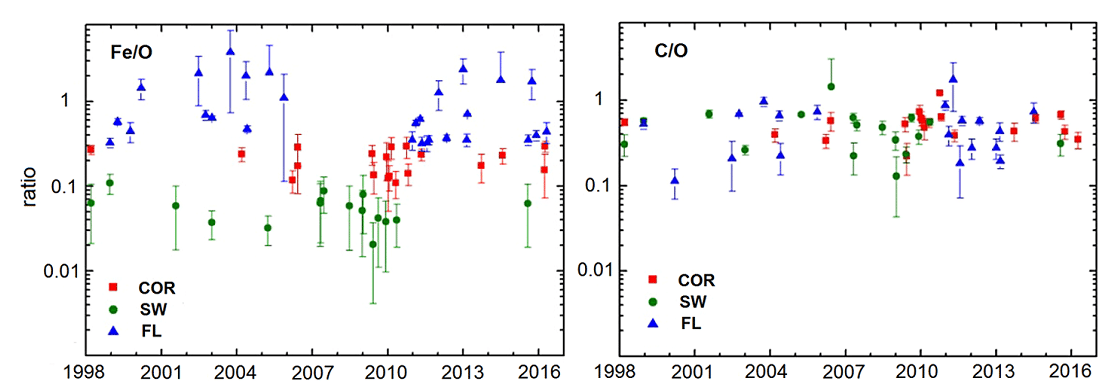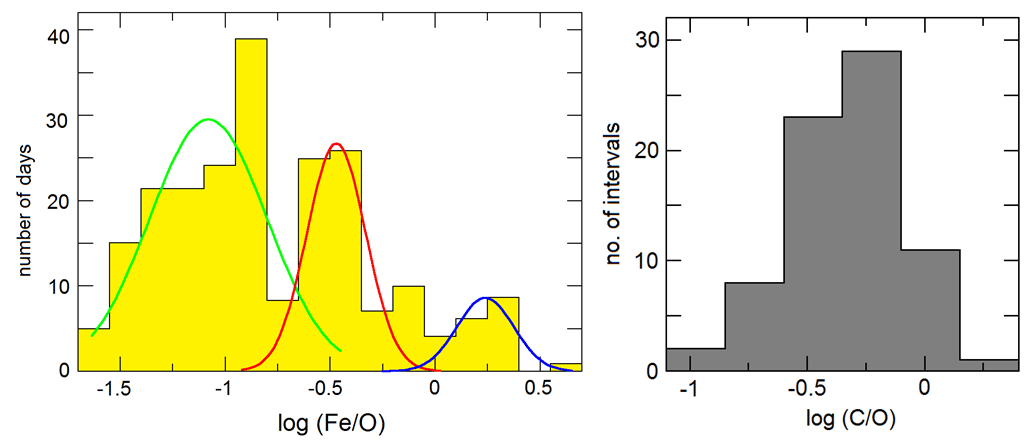
The heliosphere is filled with hot dilute plasma known as solar wind. Due to thermal collisions, the velocity distribution of ions follows a Maxwell distribution. The measured energy spectrum of the ions above the peak at about 1 keV/nucleon, however, is not falling off as rapidly as the Maxwell distribution would predict. Instead, the spectrum exhibits a long high-energy tail extending up to several MeV.
The lower energy part of this spectrum (~10 keV – 1 MeV), known as suprathermal ions, are everywhere present in the heliosphere at all times with relatively small variations in and usually display a characteristic power-law energy spectrum with slopes between about -1.5 and -2.5. At even higher energies (above ~1 MeV/nucleon) the spectrum becomes steeper with an index of about -3. The fluxes of these energetic ions (~1 MeV to 100 MeV) are subject to huge variations exceeding 6 orders of magnitude in close relation to solar activity.
To understand the behavior of these ions accelerated to energies 4-5 orders of magnitude higher than the solar wind plasma one has to identify the seed population from which they originate and explain many processes including acceleration near the Sun, injection into the interplanetary medium, acceleration and propagation in the interplanetary space to the site of observation. During active solar conditions enhancements of fluxes of energetic particles (above ~1 MeV/nucleon) can usually be traced to flare energetic particle events on the Sun and shocks (coronal mass ejections and corotating interaction regions) traveling in the interplanetary medium.
Observations during the last, extremely deep solar minimum in 2007-2009 demonstrated that these accelerated populations are still present even during the quietest solar conditions when practically no activity is present on the Sun. The properties and origin of these populations, however, are not fully explained yet. We analyzed the measurements of various ion species in the energy range of 40 keV to 2 MeV by the ULEIS detector onboard the ACE spacecraft during quiet periods. The quiet intervals were selected using strict criteria requiring low flux of 4-8 MeV protons, low p/He ratio, no appreciable transient event and 80-160 keV Fe and O ion flux below 2 × 10−2/(cm2 s sr MeV/nucleon).

Figure 1: Abundance ratio values. Left panel: 0.08 – 0.16 MeV/n Fe/O ratios in quiet periods. Color marks refer to typical coronal (COR), solar wind (SW)and flare (FL) composition. Right panel: C/O ratios for the same time period. Republished with permission from Springer from Zeldovich, M.A., Logachev, Y.I. & Kecskeméty, K. Sol Phys (2018) 293: 3. https://doi.org/10.1007/s11207-017-1170-8
It has been established earlier that the behavior of heavy ions in the solar atmosphere is governed by the value of their first-ionization potential (FIP). The FIP values of the ions observed: Fe 7.9 eV, C 11.3 eV, O 13.6 eV, and He 24.6 eV. Spectroscopic measurements showed that when taking their photospheric value as a baseline, low-FIP (defined as <10 eV) elements are overabundant in the solar corona by about a factor 4 to 5 while elements with FIP ≥ 10 eV (high-FIP) remain unchanged. A similar enhancement is also observed in the slow solar wind amounting typically to a factor of 4 while it is about 2 in the fast solar wind. This way the flux ratio of a low-FIP and a high-FIP element within a time period offers a possibility to find the source of the ions.
Therefore we looked at the time variation of the Fe/O ratio and found it highly variable in contrast to the C/O and 3He/4He ratios, i.e. relative fluxes of two high-FIP ions, which are relatively stable. Using flux data from the ULEIS/ACE detector we calculated both the Fe/O and C/O ratio for ions with energies 80-160 keV/nucleon for all quiet intervals between 1998 and 2016, covering nearly two solar cycles (Figure 1, Solar Phys. (2018) 293:3). It is immediately obvious that during high solar activity, even in lack of identifiable solar/interplanetary events, the Fe/O ratio is high, close to the typical value (0.8) observed during flare-related impulsive solar energetic particle events. Near solar minimum, this ratio is usually close to the average solar wind value (0.09) while in moderate activity periods it is near the mean coronal value, about 0.25. For comparison, the C/O ratio exhibit much smaller variability and no tendency of grouping according to the population type determined on the basis of the Fe/O ratio.

Figure 2: Histograms of the logarithms of Fe/O and C/O ratios. Republished with permission from Springer from Zeldovich, M.A., Logachev, Y.I. & Kecskeméty, K. Sol Phys (2018) 293: 3. https://doi.org/10.1007/s11207-017-1170-8
To confirm that the particles indeed split into three different populations, histograms of the Fe/O distributions were obtained from the daily average fluxes. Figure 2 displays the distributions of relative abundances counting the number of days with an average Fe/O in logarithmic bins. Three peaks are apparent which can be fitted by Gaussians with maxima of Fe/O at about 1.6 (FL), 0.32 (COR) and 0.08 (SW) respectively, close to their average values.
Although the statistics are not large, it still clearly suggests the existence of three separate populations. For comparison, the histogram of the C/O ratios is easily fitted with one wide Gaussian. The results indicate that the relative suprathermal ion abundances 3He/4He, C/O and Fe/O, as well as their variability, were different in the last two consecutive solar cycles. To explain these results we suggest that these ions were accelerated to suprathermal energies under different conditions in the solar corona in the two cycles.
The findings can be for in the article titled Quiet-time 0.04–2 MeV/nucleon0.04–2 MeV/nucleon Ions at 1 AU in Solar Cycles 23 and 24, published in the journal Solar Physics. This work was led by Károly Kecskeméty from the Wigner Research Centre for Physics.









